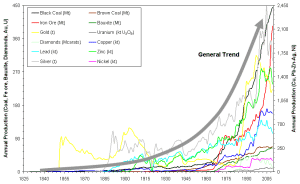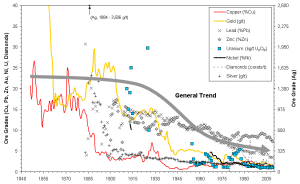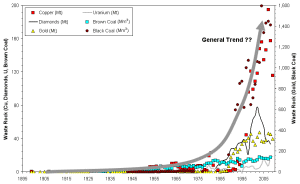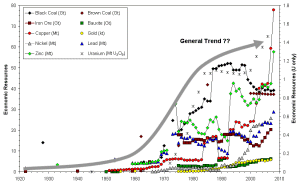The Sustainability of Mining in Australia -
Key Production Trends and Their Environmental Implications for the Future
Landmark Research Report on Australia's Mining Industry
Published by the Department of Civil Engineering, Monash University and the Mineral Policy Institute.
Author - Dr Gavin M Mudd
Released October 2007, Revised April 2009
Executive Summary
The sustainability of mining is not a simple concept - at first glance it would appear to be an obvious oxymoron, a paradox. Yet in reality, most mineral production is sometimes two or three orders of magnitude higher than a century ago, commonly from mines which dwarf their previous generation. There are clearly numerous aspects and issues involved in assessing the sustainability of mining, and the emphasis will largely vary according to whether one is adopting a mining industry, government or independent civic perspective.
In the past few decades the mining industry in Australia has moved to improve its environmental management, and in the past decade has been prominently involved in the global debate about sustainability and the need to incorporate sustainable development into mine operations as well as corporate policy.
There remains, however, no previous study which has examined long-term trends in mining which are critical in understanding sustainability and mining. The principal issues include increasing production, declining ore grades (or quality), increased open cut mining and associated waste rock or overburden and remaining economic resources. Combined, these aspects are critical in quantifying the scale or footprint of mining, and also underpins the sustainability of mining.
This report presents the first ever such study which has compiled master data sets on the above issues for almost all sectors of the Australian mining industry, namely black and brown coal, uranium, iron ore, bauxite, manganese, mineral sands, copper, gold, lead-zinc-silver, nickel and diamonds (tin and tungsten being excluded). The report contains data essentially from the start of each sector studied, sometimes back as far as 1829.
The unique study illustrates a number of key aspects concerning mining and sustainability:
- Production: gradually or exponentially increasing, which is likely to continue for some time;
- Ore Grades: gradually declining, unlikely to ever increase in the future with some metals likely to decrease by about half in the near future (eg. gold);
- Open Cut Mining: now widespread, likely to be sustained in the future though the long-term is hard to predict as new mineral deposits are likely to be deeper;
- Waste Rock / Overburden: increasing rapidly, likely to be sustained in the future and closely linked to open cut mining (especially for coal and base metals);
- Economic Resources: commonly increasing but some remain stable or gradually declining, future linked closely to exploration, technology and economics.
From a sustainability perspective, these trends point to the scale of mines and the associated footprint gradually increasing in the future. This is due to the increased solid wastes (tailings and waste rock) per unit mineral / metal production caused by declining ore grades and increased waste rock and open cut mining.
In terms of economic resources, this study demonstrates that for most minerals resources have actually increased over time despite increasing production (e.g copper, gold, nickel, mineral sands), but for some minerals rapidly increasing production is putting pressure on known economic resources (eg. iron ore).
All of these combined trends have important social, environmental and economic implications for mining. They give hope to some but cause for concern for others.
Ultimately, the sustainability of the mining industry continues to hang in the balance.

Increasing Production |

Declining Ore Grades |

Increasing Waste Rock |

Economic Resources |
Link back to Personal page or email Gavin.
Last Updated 20 September 2010



